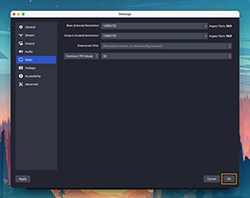Stream & Encoder Settings - OpenBroadcaster - Storm Streaming Cloud
In this guide, you will learn how to properly configure the streaming encoding settings in the OpenBroadcaster (OBS) software for Storm Streaming Cloud.
Video Tutorial
Theory - Preparation
Before we choose the appropriate parameters for our stream, we need to take three key issues into consideration:
- Internet Connection & Stability
Firstly, we must ensure that our computer (or any other device we use) has a sufficiently fast and stable Internet connection. By speed, we mean the rate of data upload to the Internet (which is not the same as "download"), and stability as the percentage of lost/dropped packets to the server. We will be responsible for some things (our local network), and our Internet Service Provider (ISP) for others.
- Hardware Computing Power
The second issue is the hardware itself. The process of encoding images is very resource-intensive. Modern computers, phones, or tablets have no major problems playing back images even in 4K resolution. However, image encoding is a much more demanding process and not every device can handle it.
It's worth mentioning a phenomenon called "thermal throttling" here as well. This refers to the decrease in performance, for example, the processor when it starts to overheat. We may find that initially our stream is smooth, but after several minutes the performance starts to drop drastically.
- The technical capabilities of your viewers
The last, but no less important, issue is your viewers' hardware and Internet. If you use the Transcoding option, your streams will automatically be converted to lower versions with lower resolution and bitrate. It's worth then broadcasting with the highest possible quality. However, in the case of Passthrough subscriptions, the stream you broadcast is exactly the one your viewers will see. It's worth lowering the requirements in relation to the connection as much as possible.
Additionally, here are a few tips from us:- Whenever possible, connect your computer to the router using an Ethernet cable (Wi-Fi is bad).
- Mobile LTE-based internet connections usually perform poorly for streaming.
- Check for packet loss to the streaming server. The packet loss value should not exceed 0.01%.
- Firewall software and antivirus programs can interfere with streaming. It may be worth temporarily disabling them.
- Once you have ensured that your internet connection is stable, it's important to consider the hardware aspect. As mentioned before, the video encoding process is resource-intensive. Close unnecessary programs and services on your computer.
- Computers can experience performance drops during continuous and intensive work, known as Thermal-Throttling. Ensure your device has proper cooling, especially for notebook-class devices.
- Your computer should have a minimum of 4 physical CPU cores and 16 GiB of RAM.
Practice - OpenBroadcaster Configuration
- On the main program screen, select "Settings" from the menu and go to the "Output" tab.
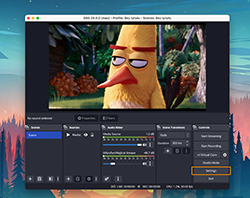
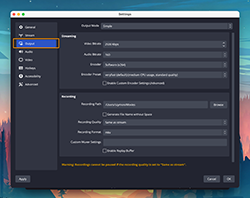
- Change the "Output Mode" (at the top) to "Advanced".
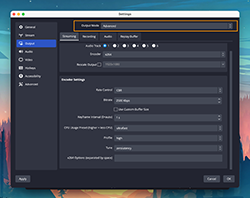
- Choose the x264 encoder. It is recommended and well-tested. If you have an NVIDIA graphics card, you can try selecting the NVENC option.
Further encoder settings:
- Rate Control - Choose CBR for the best option.
- Bitrate - Use the table below to select the appropriate value based on your target stream resolution and frames per second (fps).
Resolution FPS Bitrate 1920x1080 60 6000 1920x1080 30 4500 1280x720 60 4500 1280x720 30 3000 Table 1. required bitrate for different resolutions table - Keyframe Interval - 1s
- CPU Usage Preset - ultrafast
- Profile - high
- Tune - zerolatency
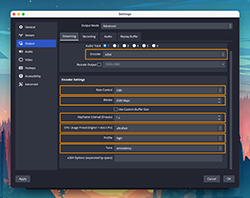
- Set the correct video resolution. Go to the "Video" tab. You will find two parameters: "Base (Canvas) Resolution" and "Output (Scaled) Resolution." Set both to your target resolution. For FPS value we suggest to set it to 30.
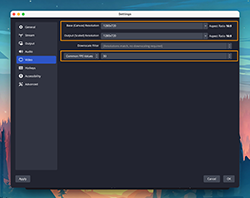
- Finally, confirm the settings by clicking the "OK" button, and you're ready to start streaming!
